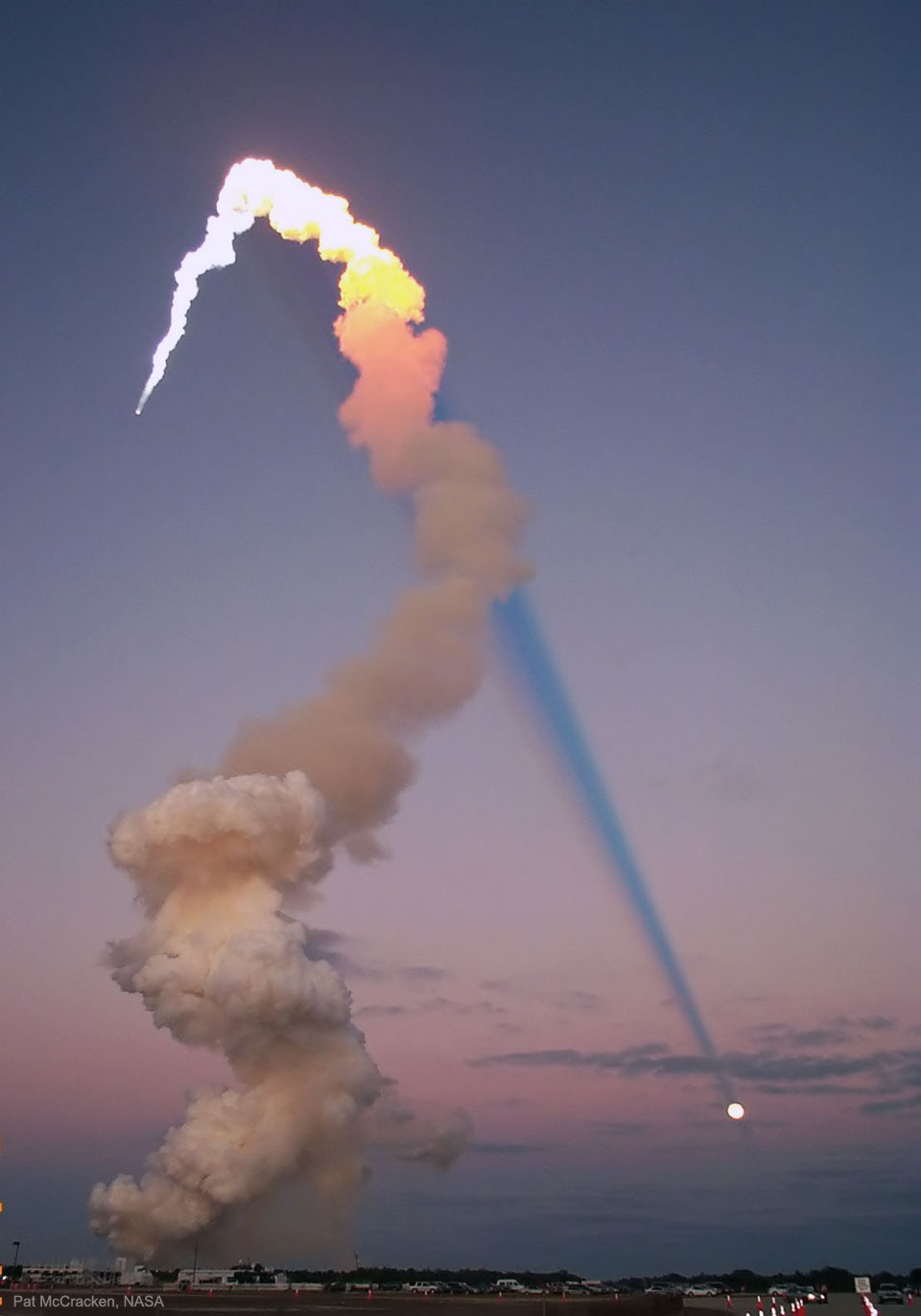11. February 2024
火箭發射,煙 ê 烏影 指向月娘

探索宇宙1!逐工會揀一幅無仝款 ê 影像抑是相片,𤆬你熟似咱這个迷人 ê 宇宙,閣有專業天文學者2為你解說3。
- 原始文章:Rocket Plume Shadow Points to the Moon
- 影像來源:Pat McCracken, NASA
- 超空間:APOD 亂數產生器
- 台文翻譯:An-Li Tsai (NSYSU)
[漢羅] 火箭發射,煙 ê 烏影 指向月娘
是按怎 火箭發射,煙 ê 烏影 會指向月娘? 2001 年初,Atlantis 號 太空梭 發射 ê 時陣,太陽、地球、月球、kah 火箭,拄仔好 排做一逝,才有這張相片。 欲翕出這張相片,代先,太空梭 發射,煙愛投影出長長 ê 烏影,時間愛 tī 日出 抑是 日落 前後。 干焦 tī 這款時間,烏影 會搝甲上長,伸 tùi 地平線彼爿去。 落尾,若是去拄著 月圓,日頭 kah 月娘 會出現 tī 天頂無仝爿。 日落 了後,日頭拄沉落去 地平線 下底,月娘會 ùi 另外一爿 ê 地平線 浮出來。 所以,Atlantis 號太空梭若是 tī 月圓彼工,等到日落了後才發射,伊 ê 烏影就會投影 tī kah 日頭 相對面、拄 ùi 地平線 peh 起來 ê 月圓 方向。
[POJ] Hóe-chìⁿ hoat-siā, ian ê o͘-iáⁿ chí-hiòng Goe̍h-niû
Sī-án-chóaⁿ hóe-chìⁿ hoat-siā, ian ê o͘-iáⁿ ē chí-hiòng goe̍h-niû? 2001 nî-chhe, Atlantis hō thài-khong-so hoat-siā ê sî-chūn, Thài-iông, Tē-kiû, Goe̍h-kiû, kah hóe-chìⁿ, tú-á-hó pâi-chò chi̍t-chōa, chiah ū chit-tiuⁿ siòng-phìⁿ. Beh hip chhut chit-tiuⁿ siòng-phìⁿ, tāi-seng, thài-khong-so hoat-siā, ian ài tâu-iáⁿ chhut tn̂g-tn̂g ê o͘-iáⁿ, sî-kan ài tī ji̍t-chhut ia̍h-sī ji̍t-lo̍h chêng-āu. Kan-na tī chit-khoán sî-kan, o͘-iáⁿ ē giú kah siōng tn̂g, chhun tùi tē-pêng-sòaⁿ hit-pêng khì. Lo̍h-bóe, nā-sī khì tú-tio̍h Goe̍h-îⁿ, ji̍t-thâu kah goe̍h-niû ē chhut-hiān tī thiⁿ-téng bô-kâng pêng. Ji̍t-lo̍h liáu-āu, ji̍t-thâu tú tîm lo̍h-khì tē-pêng-sòaⁿ ē-té, goe̍h-niû ē ùi lēng-gōa chi̍t-pêng ê tē-pêng-sòaⁿ phû-chhut-lâi. Só͘-í, Atlantis hō thài-khong-so nā-sī tī goe̍h-îⁿ hit-kang, tán-kàu ji̍t-lo̍h liáu-āu chiah hoat-siā, i ê o͘-iáⁿ tō ē tâu-iáⁿ tī kah ji̍t-thâu sio-tùi-bīn, tú ùi tē-pêng-sòaⁿ peh–khí-lâi ê goe̍h-îⁿ hong-hiòng.
[KIP] Hué-tsìnn huat-siā, ian ê oo-iánn tsí-hiòng Gue̍h-niû
Sī-án-tsuánn hué-tsìnn huat-siā, ian ê oo-iánn ē tsí-hiòng gue̍h-niû? 2001 nî-tshe, Atlantis hō thài-khong-so huat-siā ê sî-tsūn, Thài-iông, Tē-kiû, Gue̍h-kiû, kah hué-tsìnn, tú-á-hó pâi-tsò tsi̍t-tsuā, tsiah ū tsit-tiunn siòng-phìnn. Beh hip tshut tsit-tiunn siòng-phìnn, tāi-sing, thài-khong-so huat-siā, ian ài tâu-iánn tshut tn̂g-tn̂g ê oo-iánn, sî-kan ài tī ji̍t-tshut ia̍h-sī ji̍t-lo̍h tsîng-āu. Kan-na tī tsit-khuán sî-kan, oo-iánn ē giú kah siōng tn̂g, tshun tuì tē-pîng-suànn hit-pîng khì. Lo̍h-bué, nā-sī khì tú-tio̍h Gue̍h-înn, ji̍t-thâu kah gue̍h-niû ē tshut-hiān tī thinn-tíng bô-kâng pîng. Ji̍t-lo̍h liáu-āu, ji̍t-thâu tú tîm lo̍h-khì tē-pîng-suànn ē-té, gue̍h-niû ē uì līng-guā tsi̍t-pîng ê tē-pîng-suànn phû-tshut-lâi. Sóo-í, Atlantis hō thài-khong-so nā-sī tī gue̍h-înn hit-kang, tán-kàu ji̍t-lo̍h liáu-āu tsiah huat-siā, i ê oo-iánn tō ē tâu-iánn tī kah ji̍t-thâu sio-tuì-bīn, tú uì tē-pîng-suànn peh–khí-lâi ê gue̍h-înn hong-hiòng.
[English] Rocket Plume Shadow Points to the Moon
Why would the shadow of a rocket’s launch plume point toward the Moon? In early 2001 during a launch of the space shuttle Atlantis, the Sun, Earth, Moon, and rocket were all properly aligned for this photogenic coincidence. First, for the space shuttle’s plume to cast a long shadow, the time of day must be either near sunrise or sunset. Only then will the shadow be its longest and extend all the way to the horizon. Finally, during a Full Moon, the Sun and Moon are on opposite sides of the sky. Just after sunset, for example, the Sun is slightly below the horizon, and, in the other direction, the Moon is slightly above the horizon. Therefore, as Atlantis blasted off, just after sunset, its shadow projected away from the Sun toward the opposite horizon, where the Full Moon happened to be.
詞彙學習(漢羅/POJ/KIP/華語/English)
- 【Atlantis 號太空梭】Atlantis hō thài-khong-so/Atlantis hō thài-khong-so//space shuttle Atlantis
- 【月圓】goe̍h-îⁿ/gue̍h-înn/滿月/full moon
- 【火箭】hóe-chìⁿ/hué-tsìnn/火箭/rocket
- 【地平線】tē-pêng-sòaⁿ/tē-pîng-suànn/地平線/horizon